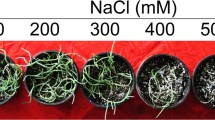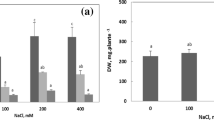Abstract
Kochia sieversiana (Pall.) C. A. M., a naturally alkali-resistant halophyte, was chosen as the test organism for our research. The seedlings of K. sieversiana were treated with varying (0–400 mM) salt stress (1:1 molar ratio of NaCl to Na2SO4) and alkali stress (1:1 molar ratio of NaHCO3 to Na2CO3). The concentrations of various solutes in fresh shoots, including Na+, K+, Ca2+, Mg2+, Cl−, SO 2−4 , NO −3 , H2PO −3 , betaine, proline, soluble sugar (SS), and organic acid (OA), were determined. The water content (WC) of the shoots was calculated and the OA components were analyzed. Finally, the osmotic adjustment and ion balance traits in the shoots of K. sieversiana were explored. The results showed that the WC of K. sieversiana remained higher than 6 [g g−1 Dry weight (DW)] even under the highest salt or alkali stress. At salinity levels >240 mM, proline concentrations increased dramatically, with rising salinity. We proposed that this was not a simple response to osmotic stress. The concentrations of Na+ and K+ all increased with increasing salinity, which implies that there was no competitive inhibition for absorption of either in K. sieversiana. Based on our results, the osmotic adjustment feature of salt stress was similar to that of alkali stress in the shoots of K. sieversiana. The shared essential features were that the shoots maintained a state of high WC, OA, Na+, K+ and other inorganic ions, accumulated largely in the vacuoles, and betaine, accumulated in cytoplasm. On the other hand, the ionic balance mechanisms under both stresses were different. Under salt stress, K. sieversiana accumulated OA and inorganic ions to maintain the intracellular ionic equilibrium, with close to equal contributions of OA and inorganic ions to anion. However, under alkali stress, OA was the dominant factor in maintaining ionic equilibrium. The contribution of OA to anion was as high as 84.2%, and the contribution of inorganic anions to anion was only 15.8%. We found that the physiological responses of K. sieversiana to salt and alkali stresses were unique, and that mechanisms existed in it that were different from other naturally alkali-resistant gramineous plants, such as Aneurolepidium chinense, Puccinellia tenuiflora.




Similar content being viewed by others
Abbreviations
- OA:
-
Organic acid
- OXA:
-
Oxalic acid
- SS:
-
Soluble sugar
- WC:
-
Water content
- DW:
-
Dry weight
- FW:
-
Fresh weight
References
Bao SD (1981) Determine of cation. In: Bao SD (ed) Analysis methods for soil and agriculture chemistry. China Agriculture Press, Beijing, China, pp 100–200
Brand JD, Tang C, Rathjen AJ (2002) Screening rough-seeded lupins (Lupinus pilosus Murr. and Lupinus atlanticus Glads.) for tolerance to calcareous soils. Plant Soil 245:261–275
Campbell SA, Nishio JN (2000) Iron deficiency studies of sugar beet using an improved sodium bicarbonate-buffered hydroponics growth system. J Plant Nutr 23:741–757
De-Lacerda CF, Cambraia J, Oliva MA, Ruiz HA, Prisco JT (2003) Solute accumulation and distribution during shoot and leaf development in two sorghum genotypes under salt stress. Environ Exp Bot 49:107–120
El-Samad HMA, Shaddad MAK (1996) Comparative effect of sodium carbonate, sodium sulphate, and sodium chloride on the growth and related metabolic activities of pea plants. J Plant Nutr 19:717–728
Ghoulam C, Foursy A, Fares K (2002) Effects of salt stress on growth, inorganic ions and proline accumulation in relation to osmotic adjustment in five sugar beet cultivars. Environ Exp Bot 47:39–50
Grieve CM, Grattan SR (1983) Rapid assay for determination of water-soluble quaternary-amino compounds. Plant Soil 70:303–307
Hartung W, Leport L, Ratcliffe RG, Sauter A, Duda R, Turner NC (2002) Abscisic acid concentration, root pH and anatomy do not explain growth differences of chickpea (Cicer arietinum L.) and lupin (Lupinus angustifolius L.) on acid and alkaline soils. Plant Soil 240:191–199
Kawanabe S, Zhu TC (1991) Degeneration and conservation of Aneurolepidium chinense grassland in Northern China. J Jpn Grassland Sci 37:91–99
Khan MA (2001) Experimental assessment of salinity tolerance of Ceriops tagal seedlings and saplings from the Indus delta, Pakistan. Aquat Bot 70:259–268
Khan MA, Ungar IA, Showalter AM (1999) Effects of salinity on growth, ion content, and osmotic relations in Halopyrum mocoronatum (L.) Stapf. J Plant Nutr 22:191–204
Khan MA, Ungar IA, Showalter AM (2000a) The effect of salinity on the growth, water status, and ion content of a leaf succulent perennial halophyte, Suaeda fruticosa (L.) Forssk. J Arid Environ 45:73–84
Khan MA, Ungar IA, Showalter AM (2000b) Effects of salinity on growth, water relations and ion accumulation of the subtropical perennial halophyte, Atriplex griffithii var. stocksii. Ann Bot 85:225–232
Koyama H, Kawamura A, Kihara T, Hara T, Takita E, Shibata D (2000) Overexpression of mitochondrial citrate synthase in arabidopsis thaliana improved growth on a phosphorus-limited soil. Plant Cell Physiol 41:1030–1037
Läuchli A, Lüttge U (2002) Salinity in the soil environment. In: Tanji KK (ed) Salinity: environment-plants-molecules. Boston Kluwer Academic Publishers, Boston, USA, pp 21–23
Li PH, Zhang H, Wang BS (2003) Ionic homeostasis of plant under salt stress. Acta Bot Boreal-Occident Sin 23:1810–1817
Li DH, He LY, Liu WD (2001) Correlation between abiotic-stress in soil and organic-acid secretion by root. J Wuhan Bot Res 19:497–507
Lissner J, Schierup HH, Comın FA, Astorga V (1999) Effect of climate on the salt tolerance of two Phragmites australis populations. I. Growth, inorganic solutes, nitrogen relations and osmoregulation. Aquat Bot 64:317–333
Li XF, Ma JF, Matsumoto H (2000) Pattern of aluminum-induced secretion of organic acids differs between rye and wheat. Plant Physiol 123:1537–1544
López-Millán AF, Morales F, Andaluz S, Gogorcena Y, Abadía A, Rivas JDL, Abadía J (2000) Responses of sugar beet roots to iron deficiency. Changes in carbon assimilation and oxygen use. Plant Physiol 124:885–898
Moghaieb REA, Saneoka H, Fujita K (2004) Effect of salinity on osmotic adjustment, glycinebetaine accumulation and the betaine aldehyde dehydrogenase gene expression in two halophytic plants, Salicornia europaea and Suaeda maritime. Plant Sci 166:1345–1349
Munns R (2002) Comparative physiology of salt and water stress. Plant cell Environ 25:239–250
Niu X, Bressan RA, Hasegawa PM, Pardo JM (1995) Ion homeostasis in NaCl stress environments. Plant Physiol 109:735–742
Nuttall G, Armstrong RD, Connor DJ (2003) Evaluating physicochemical constraints of calcarosols on wheat yield in the Victorian southern Mallee. Aust J Agric Res 54:487–497
Parida AK, Das AB (2005) Salt tolerance and salinity effects on plants: a review. Ecotoxicol Environ Saf 60:324–349
Peng YH, Zhu YF, Mao YQ, Wang SM, Su WA, Tang ZC (2004) Alkali grass resists salt stress through high [K+] and an endodermis barrier to Na+. J Exp Bot 55:939–949
Parker DR, Zelazny LW, Kinraide TB (1987) Improvements to the program geochem. Soil Sci Soc Am J 51:488–491
Sagi M, Dovrat A, Kipnis T, Lips H (1997) Ionic balance, biomass production, and organic nitrogen as affected by salinity and nitrogen source in annual ryegrass. J Plant Nutr 20:1291–1316
Santa-Cruz A, Martinez-Rodriguez MM, Perez-Alfocea F, Romero-Aranda R, Bolarin MC (2002) The rootstock effect on the tomato salinity response depends on the shoot genotype. Plant Sci 162:825–831
Serrano R, Rodriguez-Navarro A (2001) Ion homeostasis during salt stress in plants. Curr Opin Cell Biol 13:399–404
Sheng YM, Shi DC, Xiao HX, Xu Y (1999) Effect of mixed salts with various neutral and alkaline on the growth of sunflower. J Chin Northeast Norm Univ 4:65–69
Shi DC, Yin LJ (1992) Strain responses in Na2CO3−stressed Leymus chinensis seedlings and their mathematical analysis. Acta Bot Sin 34:386–393
Shi DC, Yin LJ (1993) Difference between salt (NaCl) and alkaline (Na2CO3) stresses on Puccinellia tenuiflora (Griseb.) Scribn et Merr. plants. Acta Bot Sin 35:144–149
Shi DC, Yin SJ, Yang GH, Zhao KF (2002) Citric acid accumulation in an alkali-tolerant plant Puccinellia tenuiflora under alkaline stress. Acta Bot Sin 44:537–540
Shi DC, Wang D (2005) Effects of various salt-alkali mixed stresses on Aneurolepidium chinense (Trin.) Kitag. Plant Soil 271:15–26
Shi DC, Sheng Y (2005) Effect of various salt-alkaline mixed stress conditions on sunflower seedlings and analysis of their stress factors. Environ Exp Bot 54:8–21
Shi DC (1995) Relaxation of Na2CO3 stress on Puccinellia tenuiflora (Griseb.) Scribn. et Merr. Plants by neutralizing with H3PO4. Acta Prataculturae Sin 4:34–38
Shi DC, Zhao KF (1997) Effects of sodium chlorideand carbonateon growth of Puccinellia tenuiflora and on present state of mineral elements in nutrient solution. Acta Prataculturae Sin 6:51–61
Song J, Feng G, Tian CY, Zhang FS (2006) Osmotic adjustment traits of Suaeda physophora, Haloxylon ammodendron and Haloxylon persicum in field or controlled conditions. Plant Sci 170:113–119
Short DC, Colmer TD (1999) Salt tolerance in the halophyte Halosarcia pergranulata subsp. Pergranulata. Ann Bot 83:207–213
Soussi M, Ocana A, Lluch C (1998) Effects of salt stress on growth, photosynthesis and nitrogen fixation in chick-pea (Cicerarietinum L.). J Exp Bot 49:1329–1337
Tang C, Turner NC (1999) The influence of alkalinity and water stress on the stomatal conductance, photosynthetic rate and growth of Lupinus angustifolius L. and Lupinus pilosus Murr. Aust J Exp Agric 39:457–464
Timpa JD, Burke JJ, Quiseberry JE, Wendt CW (1986) Effect of water stress on organic acid and carbohydrate composition of cotton plant. Plant Physiol 82:724–730
Wang BS, Zhao KF (1995) Comparison of extractive methods of Na+ and K+ in wheat leaves. Plant Physiol Commun 3:50–52
Yan H, Shi DC, Yin SJ, Zhao W (2000) Effects of saline-alkaline stress on the contents of nitrogen and several organisms of Aneurolepidium chinense. J Chin Northeast Norm Univ 32:47–52
Yan H, Zhao W, Sheng YM, Shi DC, Zhou DW (2005) Effects of alkali-stress on Aneurolepidium chinense and Helianthus annuus. Chin J Appl Ecol 16:1497–1501
Yin SJ, Shi DC, Yan H (2003) Main strain responses in the plants of Puccinellia tenuiflora (Griseb.).scribn et merr. to alkaline (Na2CO3) stress. Acta Prataculturae Sin 12:51–57
Zhao KF, Fan H, Ungar IA (2002) Survey of halophyte species in China. Plant Sci 163:491–498
Zhai YJ, Feng XH, Kang YG (1996) Pharmacognostlcal idntification of fructus Kochia sieversiana. J Chin Med Mater 6:283–285
Zheng HY, Li JD (1999) Form and dynamic trait of halophyte community. In: Zheng HY, Li JD (eds) Saline plants in songnen plain and restoration of alkaline-saline grass. Science Press, Beijing, China, pp 137–138
Zhu GL, Deng XW, Zuo WN (1983) Determination of free proline in plants. Plant Physiol Commun 1:35–37
Zhu JK (2003) Regulation of ion homeostasis under salt stress. Curr Opin Plant Biol 6:441–445
Acknowledgments
This work was supported by grants from the National Natural Science Foundation of China (No. 30671491 and No. 30571318) and the Program for Changjiang Scholars and Innovative Research Team in University from the Ministry of Education of China (IRT0519), and partly from the National Key Basic Research Program of China (2007CB106800).
Author information
Authors and Affiliations
Corresponding author
Additional information
Responsible Editor: John McPherson Cheeseman.
Rights and permissions
About this article
Cite this article
Yang, C., Chong, J., Li, C. et al. Osmotic adjustment and ion balance traits of an alkali resistant halophyte Kochia sieversiana during adaptation to salt and alkali conditions. Plant Soil 294, 263–276 (2007). https://doi.org/10.1007/s11104-007-9251-3
Received:
Accepted:
Published:
Issue Date:
DOI: https://doi.org/10.1007/s11104-007-9251-3




